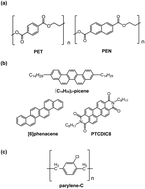Fabrication of flexible high-performance organic field-effect transistors using phenacene molecules and their application toward flexible CMOS inverters†
Abstract
The transport properties of 3,10-ditetradecylpicene ((C14H29)2-picene) and [6]phenacene thin-film field-effect transistors (FETs) on Si and plastic substrates are reported, in which SiO2 and parylene are used as gate dielectrics, respectively. These devices show p-channel normally-off FET characteristics. A μ value of 1.34 cm2 V−1 s−1 is obtained in the (C14H29)2-picene thin-film FET, where 500 μm thick polyethylene terephthalate (PET) and 1 μm thick parylene are used as the substrate and gate dielectric, respectively. Moreover, excellent FET performance is obtained in the (C14H29)2-picene thin-film FET using a high-k gate dielectric, ZrO2, which is formed on a 350 μm thick PET substrate, showing p-channel normally-off FET properties and low voltage operation. The μ value reaches 6.31 cm2 V−1 s−1 in the FET device. The FET properties of N,N′-dioctyl-3,4,9,10-perylenedicarboximide (PTCDIC8) thin-film FETs formed on PET are also reported, showing n-channel normally-off FET characteristics. We report a bias stress effect on flexible [6]phenacene thin film FETs that are fabricated on a PEN substrate. Two types of experiments are performed for investigating the bias stress effect on FETs, and the bias stress effect under light irradiation is very different from that under no irradiation. This difference is well explained based on the hole-filling of trap states by electron excitation. We show the characteristics of a complementary MOS inverter (CMOS), constituting a [6]phenecene thin-film FET (p-channel) and a PTCDIC8 thin-film FET (n-channel) formed on the PET and PEN substrates, i.e., a flexible CMOS inverter. The maximum gain reaches 300. Furthermore, we report low-voltage operation for the flexible CMOS inverter, where ZrO2 is used as the gate dielectric. Through this study, we have achieved the fabrication of flexible thin-film FETs with a high μ and low voltage operation, and flexible CMOS inverters with a high gain as well as low operation voltage. This study could provide a basis for future practical/human-compatible electronic devices.



 Please wait while we load your content...
Please wait while we load your content...